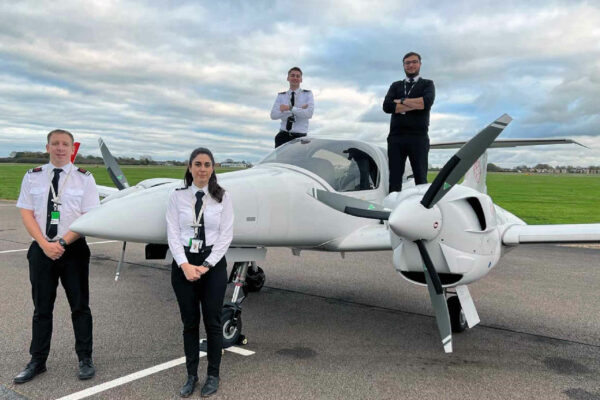It must feel sometimes that we never stop talking about airspace. In April of last year, FLYER reported on the launch of the consultation for the revised Airspace Modernisation Strategy (AMS).
The AMS is the strategy for reforming the UK’s airspace, looking forward to 2040. It was given a reboot last year, as many initiatives had stalled during the pandemic. With the aviation system running again, industry and government are looking to get the AMS back on track.
The consultation from last year has now been reviewed and a revised AMS published. It does not appear to have any significant changes from that consulted on, at least not for GA related initiatives. What has changed somewhat is the packaging of the AMS – the original 15 initiatives from 2018 have evolved into nine ‘delivery elements’, although the content is similar.
The AMS documents themselves are now in three parts, with Part 1 being conceptual, Part 2 covering the packages of change, and Part 3 (still to be published) addressing deployment.
2022 progress report
Shortly after the updated AMS was published, the CAA also issued a 2022 progress report, which gives a review of achievements so far. The 15 initiatives of the 2018 AMS are each given a status – some have made good progress, but others sit in the ‘at risk’ category. As a health check of the strategy, it is quite a good summary. Many of the technical enablers such as better radio spectrum use, electronic conspicuity, flexible use airspace tools and terminal queue management are given reasonable report cards.
The redesign of airspace is less optimistic, with progress in many areas being slow. This is not surprising though – the redesign programme requires a level of coordination between airspace stakeholders never attempted before in the UK, with around 20 individual airspace proposals in motion. Even though there is now a coordination body in the form of the Airspace Change Organising Group (ACOG), individual airports still need to do the work.
Although airports are compelled by the AMS to review their airspace, changes must still go through the demanding CAA Airspace Change Process (ACP). While the Airspace Modernisation team at the CAA and the ACOG are busy facilitating the strategy, the regulatory function of the Authority must still mark everybody’s homework. Several airports (including Manchester) have already been knocked back for not meeting pre-consultation gateway criteria.
Proposals from front runners, such as Luton and Stansted, are nearly ready for consultation on options. Early documentation gives an indication of how controlled airspace (CAS) dimensions might change – some design options could release CAS, others may not. Some of the airports, such as East Midlands and Edinburgh are barely out of the starting gates, so their intentions are less developed. There is a hope that the AMS will reduce the amount of low-level CAS, but it will be several years before we can assess the net effect.
GA and RPAS
The AMS initiatives are mostly about making the UK’s en route and terminal airspace more efficient for major airports and the commercial air transport that uses them. However, there also are many elements dedicated to operations outside controlled airspace, including the integration of remotely piloted aerial systems (RPAS).
‘Integration and flexibility of operations’ is stated to be a key priority of the AMS. Although this vision is easier said than done, it does provide an intention to measure against future outcomes.
In my previous column, we looked at Electronic Conspicuity in the context of the recent CAA and Department for Transport statement on the use of 1090 MHz and 978 MHz. I think we knew where this was going, but it remains to be seen which airspace will either require the new EC standard or confer some operational benefit from its use. For example, existing danger and restricted areas relating to RPAS activity could transition to EC mandatory zones, as and when RPAS Beyond Visual Line of Sight (BVLOS) reaches an appropriate state of maturity.
The latest version of the AMS and 2022 progress report restates several concepts such as harmonisation with ICAO Flight Information Service (FIS) and use of Radio Mandatory Zones (RMZ) around GA aerodromes, possibly replacing the Aerodrome Traffic Zone (ATZ) concept. The latter change may also allow unlicensed aerodromes to have an RMZ.
It remains to be seen exactly what the harmonised FIS would provide, but I suspect we would end up with something like France, Germany or the US ‘flight following’ service. Traffic information would therefore be provided to all participants.
The alignment with ICAO FIS would be complemented by a rationalisation of Lower Airspace Radar Services (LARS), to enable a more comprehensive and co-ordinated surveillance service for traffic outside controlled airspace.
The CAA published this infographic alongside the AMS, showing how the different pieces of the concept fit together. It is just a vision at this stage – new funding and legislation will be required for many of the ideas to become a reality. It is an attractive picture though – a world in which information about flight intent, other traffic, weather and airspace status, seamlessly flow from ground to air, air to ground, and between aerial systems.
Even if some government money is used for the future airspace infrastructure, individual airspace users and airports are almost certainly going to have to invest in new equipment to participate in this vision. This is inevitable, but as long as the benefits to users are realised, it’s probably worth it.
Timescales
Change within the airspace domain rarely happens quickly. We await a ‘Part 3’ of the AMS, which should give more detail on delivery timelines. Although, the 2022 progress report does give some indications.
For EC, the rollout is likely to be gradual, and 2024 is mooted in the progress report as being the timescale for deployment, although it’s not clear exactly what this means. The first operational deployments of the new EC standard may take place in 2024, but this would be subject to ongoing work.
Judging by the rate of progress on airspace redesign, I suspect it will be several years, for example, before the London Terminal Manoeuvring Area starts to change shape. The current airspace redesign programme may be ongoing until at least the end of 2026 – and likely beyond.
For the reorganisation of FIS in the UK, 2027 is mentioned in the progress report as being the likely timescale – to bring the idea to reality will be a five-year project.
No doubt we will be returning to this subject in the future.







